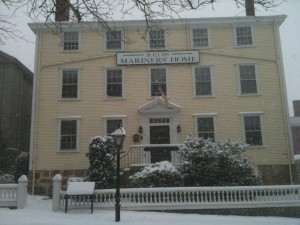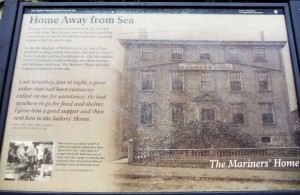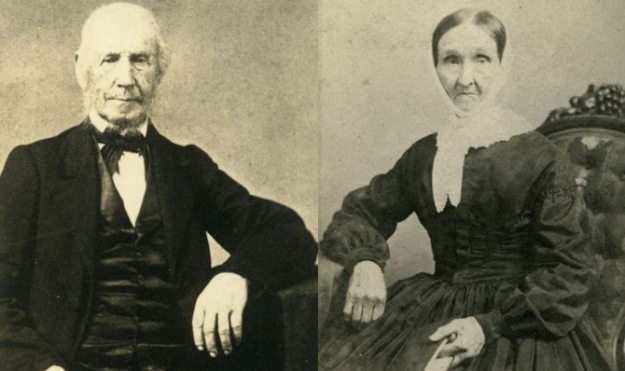
New Bedford’s downtown area is filled with beautiful cobblestone streets, quaint shops and restaurants, and historic landmarks. Having an intrinsic tie with the ocean, New Bedford’s rich history never seems to end! Located in downtown is the historic Johnny Cake Hill, and placed on the Hill next to the Seamen’s Bethel is the Mariner’s Home. The Mariners’ Home has a deep and interesting tie to New Bedford and one of the city’s most prominent families-the Rotch family.
Built in 1787, the Mariners’ Home was first a home for William Rotch Jr., located on what is now the corner of Water and William Streets. However, the history of the Home could be traced back to 1765, which is when the Rotch family moved from the island of Nantucket to New Bedford.
Joseph Rotch, the grandfather of William Rotch Jr., was an accomplished sailor and captain, and laborer in the shore side of the whaling industry. After living and working on Nantucket for years, at the age of 61, Joseph Rotch decided to move himself and two of his adult sons to New Bedford. His wife, Love Rotch, and eldest son, William Rotch, continued to live on Nantucket. The whaling industry in Nantucket had slowly started to decline, but the whaling in New Bedford continued to prosper. Joseph Rotch bought a 10-acre plot of land and built his first home upon it. Interestingly, the auditorium of the Whaling Museum now sits upon the location of his first home on the southwest corner of William and Water Street.
 From 1765 through 1775 whaling continued to grow due to the influence and finances of the Rotches. However, at this time the Revolutionary War broke out and in 1778 British troops landed in Clark’s Cove and made their way to downtown New Bedford. The troops destroyed whaling facilities, major homes built by prominent people of New Bedford, and businesses. Joseph Rotch’s house was destroyed by torching. Thankfully, Joseph Rotch had moved back to Nantucket and spent most of his time there since the outbreak of the war in 1775. However, due to their prominence, the Rotches had to be careful of where to place their allegiance during the war, and instead tried to remain neutral. During this time Joseph Rotch’s whaling and merchant business came to a standstill.
From 1765 through 1775 whaling continued to grow due to the influence and finances of the Rotches. However, at this time the Revolutionary War broke out and in 1778 British troops landed in Clark’s Cove and made their way to downtown New Bedford. The troops destroyed whaling facilities, major homes built by prominent people of New Bedford, and businesses. Joseph Rotch’s house was destroyed by torching. Thankfully, Joseph Rotch had moved back to Nantucket and spent most of his time there since the outbreak of the war in 1775. However, due to their prominence, the Rotches had to be careful of where to place their allegiance during the war, and instead tried to remain neutral. During this time Joseph Rotch’s whaling and merchant business came to a standstill.
After the war, the Rotches built up their whaling and mercantile industry both on Nantucket and New Bedford. Joesph Rotch did not return to New Bedford, and died at the age of 81 on the island of Nantucket.
The next era of Rotches to return to New Bedford were William Rotch Jr., the grandson of Joseph Rotch and the son of William Rotch, and his wife, Elizabeth, and their daughter, Sarah. Having received the 10-acre plot that his grandfather owned, William Rotch Jr. built his home on the same southwest corner of William and Water Streets in 1787. In 1828 William Rotch Jr’s first wife died, and a little over a year later he remarried a woman by the name of Lydia Fox. By this time in the 1830’s it was no longer fashionable to live near the waterfront, and Lydia preferred to live higher up on a hill where wealthier people lived. The Rotches lived in their first home until 1834, and then moved to County Street into what is now the Rotch-Jones-Duff House and Garden Museum. Their first home was donated in 1850 by Sarah Rotch-Arnold to the New Bedford Port Society and became the Mariner’s Home.
Little is known about what the house was used for between 1834 and 1850. Nevertheless, the house was left to William Rotch Jr.’s daughter, Sarah Rotch Arnold, after his death in 1850. It was relocated to its present site upon Johnny Cake Hill and, supposedly, it was moved by using oxen to drag it about a city block. Also, $3,000 was raised by the Ladies Branch of the Port Society to furnish the home and make it comfortable for sailors.
 The Home was opened in 1851 and it was originally called the Acushnet House. The house was built for seamen who wanted a clean and wholesome place to board and take shelter in for some time. Within the House there were kitchen and dining facilities, bedrooms, a front room, a parlor room, a bedroom for Mary Dodge who was the live-in superintendent when the Home first opened, a library, a recreational room for the mariners, and a hospital room.
The Home was opened in 1851 and it was originally called the Acushnet House. The house was built for seamen who wanted a clean and wholesome place to board and take shelter in for some time. Within the House there were kitchen and dining facilities, bedrooms, a front room, a parlor room, a bedroom for Mary Dodge who was the live-in superintendent when the Home first opened, a library, a recreational room for the mariners, and a hospital room.
During the early years, the Home was active and full with men shipping out to sea, men coming back from voyages, and men infected with tuberculosis. Tuberculosis was a rampant problem among seamen and the close quarters of the ships made it impossible to become infected. The private enterprise hospital only lasted a few years, and subsequently the women of the Ladies Branch of the Port Society catered to the whalers sick with tuberculosis.
As the years went on the Mariners’ Home became less active allowing for more people to have rooms. In 1889 the Port Society started providing living quarters in the Mariners’ Home to the chaplains of the Seamen’s Bethel. From that time on most chaplains and their wives lived in the Home.
Over the years the Mariners’ Home has changed. At one point it was used as a retirement place for old mariners, a place of refuge for homeless, and up until two years ago rooms could still be rented for use. The Mariners’ Home closed two years ago and tours are not available. However, the Home can still be looked upon and viewed as one of the most historical places of New Bedford.
– New Bedford Guide Your Guide to New Bedford and South Coast, MA
New Bedford Guide Your Guide to New Bedford and South Coast, MA












